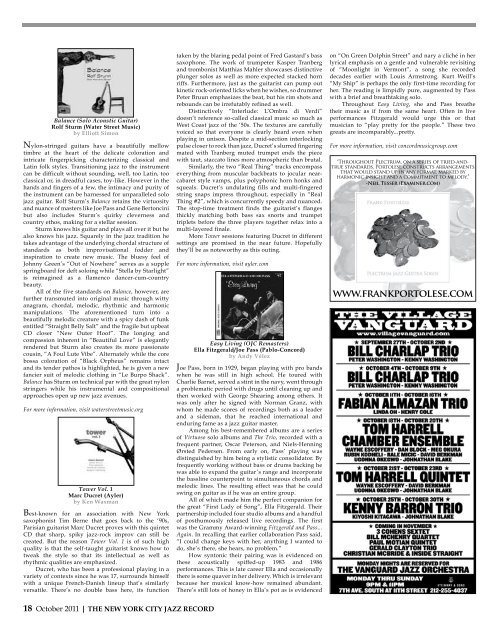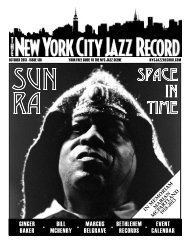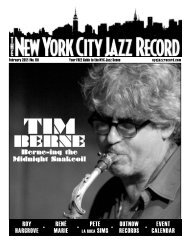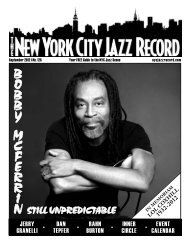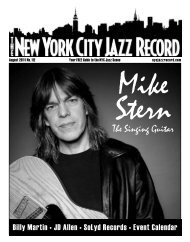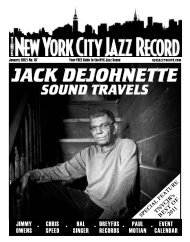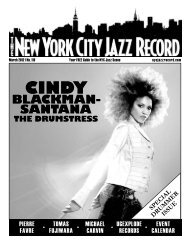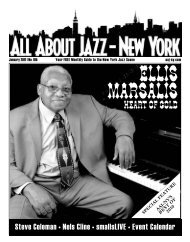Return of the Guitar Man - The New York City Jazz Record
Return of the Guitar Man - The New York City Jazz Record
Return of the Guitar Man - The New York City Jazz Record
You also want an ePaper? Increase the reach of your titles
YUMPU automatically turns print PDFs into web optimized ePapers that Google loves.
Balance (Solo Acoustic <strong>Guitar</strong>)<br />
Rolf Sturm (Water Street Music)<br />
by Elliott Simon<br />
Nylon-stringed guitars have a beautifully mellow<br />
timbre at <strong>the</strong> heart <strong>of</strong> <strong>the</strong> delicate coloration and<br />
intricate fingerpicking characterizing classical and<br />
Latin folk styles. Transitioning jazz to <strong>the</strong> instrument<br />
can be difficult without sounding, well, too Latin, too<br />
classical or, in dreadful cases, toy-like. However in <strong>the</strong><br />
hands and fingers <strong>of</strong> a few, <strong>the</strong> intimacy and purity <strong>of</strong><br />
<strong>the</strong> instrument can be harnessed for unparalleled solo<br />
jazz guitar. Rolf Sturm’s Balance retains <strong>the</strong> virtuosity<br />
and nuance <strong>of</strong> masters like Joe Pass and Gene Bertoncini<br />
but also includes Sturm’s quirky cleverness and<br />
country ethos, making for a stellar session.<br />
Sturm knows his guitar and plays all over it but he<br />
also knows his jazz. Squarely in <strong>the</strong> jazz tradition he<br />
takes advantage <strong>of</strong> <strong>the</strong> underlying chordal structure <strong>of</strong><br />
standards as both improvisational fodder and<br />
inspiration to create new music. <strong>The</strong> bluesy feel <strong>of</strong><br />
Johnny Green’s “Out <strong>of</strong> Nowhere” serves as a supple<br />
springboard for deft soloing while “Stella by Starlight”<br />
is reimagined as a flamenco dancer-cum-country<br />
beauty.<br />
All <strong>of</strong> <strong>the</strong> five standards on Balance, however, are<br />
fur<strong>the</strong>r transmuted into original music through witty<br />
anagram, chordal, melodic, rhythmic and harmonic<br />
manipulations. <strong>The</strong> aforementioned turn into a<br />
beautifully melodic creature with a spicy dash <strong>of</strong> funk<br />
entitled “Straight Belly Salt” and <strong>the</strong> fragile but upbeat<br />
CD closer “<strong>New</strong> Outer Ho<strong>of</strong>”. <strong>The</strong> longing and<br />
compassion inherent in “Beautiful Love” is elegantly<br />
rendered but Sturm also creates its more passionate<br />
cousin, “A Foul Lute Vibe”. Alternately while <strong>the</strong> core<br />
bossa coloration <strong>of</strong> “Black Orpheus” remains intact<br />
and its tender pathos is highlighted, he is given a new<br />
fancier suit <strong>of</strong> melodic clothing in “Le Burpo Shack”.<br />
Balance has Sturm on technical par with <strong>the</strong> great nylon<br />
stringers while his instrumental and compositional<br />
approaches open up new jazz avenues.<br />
For more information, visit waterstreetmusic.org<br />
Tower Vol. 1<br />
Marc Ducret (Ayler)<br />
by Ken Waxman<br />
Best-known for an association with <strong>New</strong> <strong>York</strong><br />
saxophonist Tim Berne that goes back to <strong>the</strong> ‘90s,<br />
Parisian guitarist Marc Ducret proves with this quintet<br />
CD that sharp, spiky jazz-rock improv can still be<br />
created. But <strong>the</strong> reason Tower Vol. 1 is <strong>of</strong> such high<br />
quality is that <strong>the</strong> self-taught guitarist knows how to<br />
tweak <strong>the</strong> style so that its intellectual as well as<br />
rhythmic qualities are emphasized.<br />
Ducret, who has been a pr<strong>of</strong>essional playing in a<br />
variety <strong>of</strong> contexts since he was 17, surrounds himself<br />
with a unique French-Danish lineup that’s similarly<br />
versatile. <strong>The</strong>re’s no double bass here, its function<br />
18 October 2011 | THE NEW YORK CITY JAZZ RECORD<br />
taken by <strong>the</strong> blaring pedal point <strong>of</strong> Fred Gastard’s bass<br />
saxophone. <strong>The</strong> work <strong>of</strong> trumpeter Kasper Tranberg<br />
and trombonist Matthias Mahler showcases distinctive<br />
plunger solos as well as more expected stacked horn<br />
riffs. Fur<strong>the</strong>rmore, just as <strong>the</strong> guitarist can pump out<br />
kinetic rock-oriented licks when he wishes, so drummer<br />
Peter Bruun emphasizes <strong>the</strong> beat, but his rim shots and<br />
rebounds can be irrefutably refined as well.<br />
Distinctively “Interlude: L’Ombra di Verdi”<br />
doesn’t reference so-called classical music so much as<br />
West Coast jazz <strong>of</strong> <strong>the</strong> ‘50s. <strong>The</strong> textures are carefully<br />
voiced so that everyone is clearly heard even when<br />
playing in unison. Despite a mid-section interlocking<br />
pulse closer to rock than jazz, Ducret’s slurred fingering<br />
mated with Tranberg muted trumpet ends <strong>the</strong> piece<br />
with taut, staccato lines more atmospheric than brutal.<br />
Similarly, <strong>the</strong> two “Real Thing” tracks encompass<br />
everything from muscular backbeats to jocular nearcabaret<br />
style vamps, plus polyphonic horn honks and<br />
squeals. Ducret’s undulating fills and multi-fingered<br />
string snaps impress throughout, especially in “Real<br />
Thing #2”, which is concurrently speedy and nuanced.<br />
<strong>The</strong> stop-time treatment finds <strong>the</strong> guitarist’s flanges<br />
thickly matching both bass sax snorts and trumpet<br />
triplets before <strong>the</strong> three players toge<strong>the</strong>r relax into a<br />
multi-layered finale.<br />
More Tower sessions featuring Ducret in different<br />
settings are promised in <strong>the</strong> near future. Hopefully<br />
<strong>the</strong>y’ll be as noteworthy as this outing.<br />
For more information, visit ayler.com<br />
Easy Living (OJC Remasters)<br />
Ella Fitzgerald/Joe Pass (Pablo-Concord)<br />
by Andy Vélez<br />
Joe Pass, born in 1929, began playing with pro bands<br />
when he was still in high school. He toured with<br />
Charlie Barnet, served a stint in <strong>the</strong> navy, went through<br />
a problematic period with drugs until cleaning up and<br />
<strong>the</strong>n worked with George Shearing among o<strong>the</strong>rs. It<br />
was only after he signed with Norman Granz, with<br />
whom he made scores <strong>of</strong> recordings both as a leader<br />
and a sideman, that he reached international and<br />
enduring fame as a jazz guitar master.<br />
Among his best-remembered albums are a series<br />
<strong>of</strong> Virtuoso solo albums and <strong>The</strong> Trio, recorded with a<br />
frequent partner, Oscar Peterson, and Niels-Henning<br />
Ørsted Pedersen. From early on, Pass’ playing was<br />
distinguished by him being a stylistic consolidator. By<br />
frequently working without bass or drums backing he<br />
was able to expand <strong>the</strong> guitar’s range and incorporate<br />
<strong>the</strong> bassline counterpoint to simultaneous chords and<br />
melodic lines. <strong>The</strong> resulting effect was that he could<br />
swing on guitar as if he was an entire group.<br />
All <strong>of</strong> which made him <strong>the</strong> perfect companion for<br />
<strong>the</strong> great “First Lady <strong>of</strong> Song”, Ella Fitzgerald. <strong>The</strong>ir<br />
partnership included four studio albums and a handful<br />
<strong>of</strong> posthumously released live recordings. <strong>The</strong> first<br />
was <strong>the</strong> Grammy Award-winning Fitzgerald and Pass...<br />
Again. In recalling that earlier collaboration Pass said,<br />
“I could change keys with her, anything I wanted to<br />
do, she’s <strong>the</strong>re, she hears, no problem.”<br />
How syntonic <strong>the</strong>ir pairing was is evidenced on<br />
<strong>the</strong>se acoustically spiffed-up 1983 and 1986<br />
performances. This is late career Ella and occasionally<br />
<strong>the</strong>re is some quaver in her delivery. Which is irrelevant<br />
because her musical know-how remained abundant.<br />
<strong>The</strong>re’s still lots <strong>of</strong> honey in Ella’s pot as is evidenced<br />
on “On Green Dolphin Street” and nary a cliché in her<br />
lyrical emphasis on a gentle and vulnerable revisiting<br />
<strong>of</strong> “Moonlight in Vermont”, a song she recorded<br />
decades earlier with Louis Armstrong. Kurt Weill’s<br />
“My Ship” is perhaps <strong>the</strong> only first-time recording for<br />
her. <strong>The</strong> reading is limpidly pure, augmented by Pass<br />
with a brief and breathtaking solo.<br />
Throughout Easy Living, she and Pass brea<strong>the</strong><br />
<strong>the</strong>ir music as if from <strong>the</strong> same heart. Often in live<br />
performances Fitzgerald would urge this or that<br />
musician to “play pretty for <strong>the</strong> people.” <strong>The</strong>se two<br />
greats are incomparably...pretty.<br />
For more information, visit concordmusicgroup.com<br />
“Throughout Plectrum, on a series <strong>of</strong> tried-andtrue<br />
standards, Portolese constructs arrangements<br />
that would stand up in any format, marked by<br />
harmonic insight and a commitment to melody.”<br />
-Neil Tesser (Examiner.com)<br />
www.frankportolese.com


